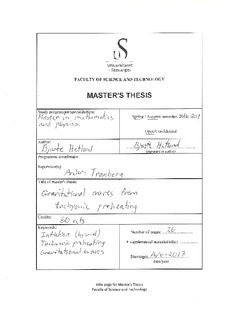| dc.description.abstract | Most models of the universe, which are in agreement with current observations, include some form of extremely rapid expansion of space at a very early stage. This is called cosmological inflation, or just inflation.
Most models of inflation include one or more scalar fields. Before 2012 we did not know if scalar fields really do exist. It has been predicted by the standard model of particle physics in order to explain the masses of elementary particles. This is the so-called Higgs field, for which the corresponding particle, the Higgs boson, was detected at CERN in July 2012 [2][3].
Scalar fields have been the key ingredients in cosmological inflation models since the early 1980's, and the discovery of the Higgs particle provides new confidence both for cosmologist and particle physicists.
The simplest models of inflation involves only one scalar field called the inflation. One obvious candidate could be the Higgs field itself as proposed in [4]. However, in this thesis, we will focus on a model of two coupled fields, called hybrid inflation.
When inflation ends, the universe is left in an empty and cold state, and (for a very short while) practically all of the energy in the universe we observe today is stored in the inflaton field(s) as potential energy. As the field rapidly decays, a huge amount of particles and radiation is created. This is the origin of the radiation and matter content of the universe today.
Most, if not all models of cosmic inflation predict generation of gravitational waves. Unlike electromagnetic waves, GW's propagate relatively undisturbed through space after they are created, and thus provides us with a way to probe the universe at very early times, right after inflation has ended. Now, the predicted GW spectrum due to inflation is model-dependent, and the observed spectrum should tell us if a specific model is possible or not. And in case neither model fits the data, we might even have to reconsider inflation altogether. | nb_NO |

